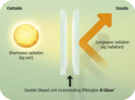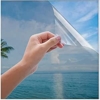You don't need to be lazy about both - if you don't do one, you don't need to do the otherI must admit lazy both opening and drawing curtains ....
Kind Regards, John
You don't need to be lazy about both - if you don't do one, you don't need to do the otherI must admit lazy both opening and drawing curtains ....

 but remember some problems when installed wrong way around. There is also add on films
but remember some problems when installed wrong way around. There is also add on films which I know work, as seen it used on a batching plant cabin where the sun was making it very hot, often referred to as one way film, as it can stop one seeing what people behind the glass are doing, definitely needs to be right way around in a bathroom, if some one thinks it is a mirror they could give a good display.
which I know work, as seen it used on a batching plant cabin where the sun was making it very hot, often referred to as one way film, as it can stop one seeing what people behind the glass are doing, definitely needs to be right way around in a bathroom, if some one thinks it is a mirror they could give a good display.I idea of replacing the third glass in summer for a fly screen seems good, but where do you put the glass? The French seemed to have a good idea with the shutters, but never been in a French home with them closed, it must be very dark?
"Brise soleil" - they work absolutely brilliantly, it made a huge difference installed on the south facing, four storey lab block where I work.In the UK, I have seen shades fitted to modern buildings, in the form of slats fitted to brackets above windows. When the sun shines near straight down, it gets to shine on the ground, but the slats limited the sun from shining in thr
I don't know what "K glass" is, but I'll try to find out when I have some moments. However, as I and others have told you, any sort of glass (at least, any sort I know of) will exhibit the 'greenhouse effect' - i.e. it will let in enough UVA that sunlight will be able to warm the inside of a building, but will prevent heat (IR) escape by radiation through the window (but some heat may go through by conduction, if it's cold outside).Also K glass™ may be an option. I think it acts as a one way valve, but which way, can it be reversed summer and winter, so in winter it lets the heat in and not out, and in summer lets heat out and not in?
I presume he means 'Pilkington K' glass?:I don't know what "K glass" is
Thanks. The description seems to suggest that it reduces even further the transparency of glass to IR but, since I thought that was pretty low in the first place (with 'ordinary' glass) I wonder how much benefit it actually provides?I presume he means 'Pilkington K' glass?:
Pilkington K Glass™ | Trusted Low‑E Thermal Insulation Glass
Pilkington K Glass™ is the original hard‑coated, low‑emissivity glass trusted across the UK for over 20 years. Designed for energy-efficient IGUs, it reflects heat back into the room while allowing solar gain | helping achieve top Window Energy Ratings and reduce heating billswww.pilkington.com
If you need to find a tradesperson to get your job done, please try our local search below, or if you are doing it yourself you can find suppliers local to you.
Select the supplier or trade you require, enter your location to begin your search.
Are you a trade or supplier? You can create your listing free at DIYnot Local
